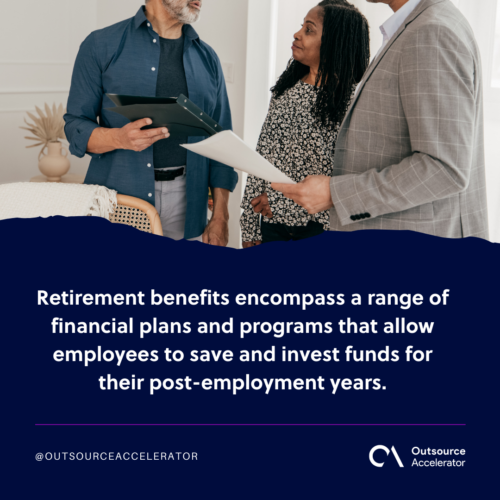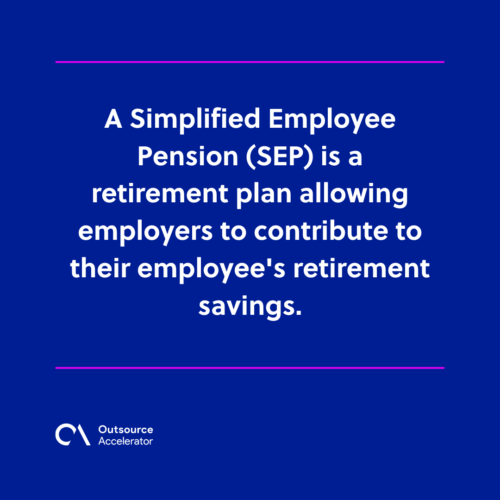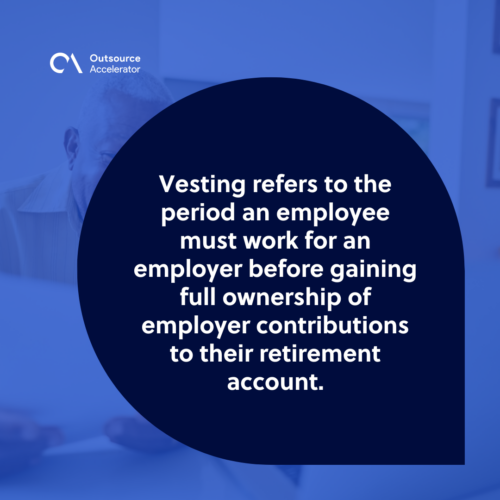Your handy guide to employee retirement benefits

Retirement benefits play a crucial role in attracting and retaining talented employees. They provide financial security and peace of mind for individuals as they plan for their future.
In today’s competitive job market, employees value retirement benefits as a vital component of their overall compensation. Therefore, both employees and employers must have a clear understanding of retirement benefit options and their significance.
Let’s explore the various aspects of employee retirement benefits, their importance, types, and factors that can affect them in this article.
The basics of retirement benefits for employees
Retirement benefits encompass a range of financial plans and programs that allow employees to save and invest funds for their post-employment years.
Retirement benefits are usually given to employees when they reduce their work hours or stop working for good. However, some employers allow their staff to retire early and get a portion of their benefits until they reach a certain age.
Employers typically offer these benefits as part of a comprehensive compensation package.

Why you should offer your employees retirement benefits
While retirement benefits give employees an advantage in terms of financial security, offering these perks also gives you an edge for the following reasons:
Reduced turnover
Retirement benefits serve as a powerful incentive for employees to stay with the company for the long haul.
One of the key advantages of offering retirement benefits is the potential for reduced employee turnover. When employees can secure their financial future, they are more likely to remain loyal to their current employer.
This can reduce the costs associated with recruiting and training new staff.
Better talent acquisition
Attracting top talent is a challenge for any organization. By offering attractive retirement benefits, employers can differentiate themselves from competitors and appeal to highly skilled professionals.
A robust retirement package can be a deciding factor for candidates weighing multiple job offers, allowing you to attract the best talent to your organization.
Security for employees
Retirement benefits provide employees with a sense of security, knowing that they are actively building a nest egg for their future. These benefits offer a financial safety net, ensuring employees have resources to rely on when they retire.
By offering retirement benefits, employers demonstrate their commitment to their employees’ well-being beyond their active years of service.
Types of retirement benefits
Retirement benefits come in various forms, each with its features and advantages. Here are some common types of retirement benefits:
401(k)
The 401(k) plan is a widely known and utilized retirement savings vehicle. It allows employees to contribute a percentage of their salary to a tax-advantaged investment account.
Employers often offer matching contributions, further enhancing the employee’s retirement savings potential. Depending on their agreement, the plan can be in the form of:
- Profit-sharing
- Stock bonus
- Pre-ERISA money purchase pension
- A rural cooperative plan
401(k) plans also have different types: traditional, safe harbor, and simple 401(k).
In traditional plans, employees are allowed to choose their investment options. Employee contributions here are tax-deferred, as well as the earnings from their investments.
Safe harbor plans work similarly to the traditional plan. However, it allows employers to avoid the regulations and expenses that come with nondiscrimination tests in most retirement plans.
Perfect for small business owners, the simple 401(k) plan allows staff to defer some compensation on their part. But companies must make either a 3% matching contribution or a 2% non-elective contribution to employee pay.
Simple IRA
A Simple Individual Retirement Account (IRA) is a plan designed for small businesses with up to 100 staff. It allows employees to contribute a percentage of their salary to an IRA, while employers can match these contributions.
Simple IRA plans offer simplicity and flexibility, making them an attractive choice for employers and employees. It works similarly to the simple 401(k) plan.
Once a business reaches over 100 staff, this plan gives them a two-year grace period to convert their staff’s retirement benefits into other forms.

Roth 401(k)
The Roth 401(k) combines traditional 401(k) and Roth IRA elements. It allows employees to make after-tax contributions to their retirement account, which can be withdrawn tax-free during retirement.
Compared to a traditional plan, Roth 401(k) requires the staff to pay their income tax immediately. With this, only their net income is reduced by the savings they elect to contribute.
The Roth 401(k) offers tax diversification, providing employees greater flexibility in managing their retirement income.
Simplified Employee Pension (SEP)
A Simplified Employee Pension (SEP) is a retirement plan allowing employers to contribute to their employee’s retirement savings. SEPs are typically used by small businesses or self-employed individuals.
SEPs have higher income requirements and annual contribution fees than most retirement benefits. One good thing about this plan is its flexibility, especially if cash flow is an issue for business owners and individuals.
Contributions made by the employer are tax-deductible, and the funds in the SEP account grow tax-deferred until retirement.
457 Plans
457 Plans are retirement plans available to government and non-profit employees. These plans offer tax advantages, allowing staff to contribute a part of their income to a retirement account before tax.
A 457 plan has two types:
- 457(b). This is the most common 457 plan offered to government employees and non-profits.
- 457(f). Meanwhile, this plan is mostly offered to executives in tax-exempt organizations.
The funds grow tax-deferred until withdrawal during retirement.
Employee qualifications for retirement benefits
Qualifications for retirement benefits can vary depending on the specific plan and employer policies. The Employee Retirement Income Security Act of 1974 (ERISA) sets the standards for retirement and health plans in private companies in the US.
Here are some common factors that may affect an employee’s eligibility for retirement benefits:
Length of service
Employers may require employees to reach a minimum length of service before becoming eligible for retirement benefits.
Employees must have at least five to ten years of service to qualify for retirement benefits before retirement age. The Social Security Administration (SSA) bases the amount a staff gets on their highest earnings within 35 years.
This criterion ensures that employees have demonstrated their commitment to the organization.
Employment status
Certain retirement benefits may only be available to full-time employees. Part-time or temporary employees may have different eligibility requirements or limited access to retirement plans, as mentioned above.
The US Bureau of Labor Statistics figures state that 68% of private workers had access to their retirement plans in 2021, with 51% participation. Meanwhile, 92% of workers in the public sector have access, with 81% participation.
Age
Some retirement benefits have age-related requirements.
The SSA states that employees may be eligible for full benefits upon retirement age 65 and can get their benefits as early as 62. Deduction for retirement plans may start as early as 21 years old.
Age criteria help employers align retirement benefits with government regulations and the typical retirement age.
Contribution thresholds
There may be minimum and maximum thresholds for contribution amounts in plans where employees contribute.
However, a plan must have a permanent date with no expirations to qualify for retirement benefits. They only have the option to change or terminate retirement benefits due to business necessity.
These thresholds ensure that employees are actively participating in their retirement savings while maintaining a balanced approach.
Vesting periods
Vesting refers to the period an employee must work for an employer before gaining full ownership of employer contributions to their retirement account.
Employers can choose from two vesting methods:
- Five-year vesting. In a five-year vesting period, employees become fully vested with their retirement plan after five years of service, with zero vesting within the first four years.
- Seven-year gradual vesting. Meanwhile, seven-year gradual vesting allows employees to be increasingly vested by up to 20% per year once they reach their third year of service.
Vesting periods prevent employees from receiving full benefits if they leave the organization too soon.

Factors affecting an employee’s retirement benefits
Several factors can influence the value and sustainability of an employee’s retirement benefits. Here are some key considerations:
- Market performance. The overall performance of the financial markets can impact the returns on retirement investments, affecting the growth of an employee’s retirement savings.
- Contribution levels. How much an employee contributes to their retirement account directly influences the growth potential of their savings. Higher contributions generally lead to greater retirement funds.
- Investment allocation. The investment choices made within retirement accounts can significantly impact their growth. Employees should consider diversifying their investments to mitigate risk and maximize returns.
- Employer contributions. The generosity of employer contributions can greatly enhance an employee’s retirement benefits. Employers who match employee contributions or make additional contributions help accelerate retirement savings.
- Economic factors. Economic conditions like inflation and interest rates can affect retirement savings’ purchasing power and growth potential.
Retirement benefits are valuable for employers to attract and retain talented employees. Employers can demonstrate their commitment to their employees’ financial well-being by offering a range of retirement options.
Understanding the basics, types, and factors affecting retirement benefits empowers employers to make informed decisions and create a thriving employee retirement ecosystem.







 Independent
Independent




